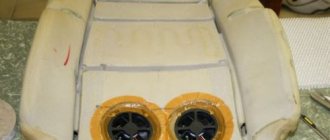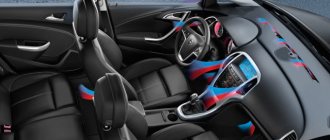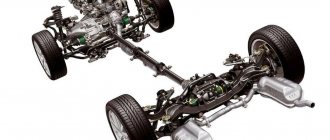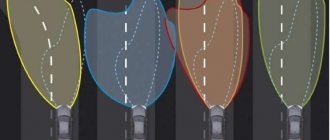The vehicle slows down solely due to the friction between the area of the tire in contact with the surface. No matter how tightly the brake disc is clamped by the pads, it is impossible to overcome the threshold of wheel adhesion to the road. Moreover, if this threshold is exceeded, the friction coefficient drops abruptly, the wheel slips and the braking intensity decreases sharply.
Why does a car have ABS?
Against this background, the most logical thing would be to reduce the braking force, which will restore traction and bring the coefficient to the maximum again.
At the same time, the second, no less important task will be solved - maintaining controllability. After all, a sliding wheel resists longitudinal and lateral forces equally weakly.
For the steered axle, this means no response to the steering wheel, the car will continue to move by inertia, and all other wheels can randomly change the direction of displacement.
The slightest unevenness in the road, the presence of torques of inertia, even the wind can send the car into a slide from which it is almost impossible to get out.
How does the ABS sensor work in simple words?
Driving a vehicle with ABS and without anti-lock wheels
The operating principle of the ABS sensor is as follows. During sudden braking, the system collects information that the wheel is not rotating, while the car is still moving. Next, the ABS sensor transmits information to the main brake system, indicating that it is necessary to reduce the braking force on this wheel, due to which the wheel lock is removed and the car comes out of the skid.
How the anti-lock braking system works
To make a decision and execute it, any automation must have an input signal, a data processing device and actuators.
Likewise, ABS, receiving a signal that the wheels have begun to lock, briefly releases the brakes on the disc or drum associated with the hub, and after contact is restored, it again applies pressure to the brake pads. The process is repeated dozens of times per second, which, as a result of averaging the pulse effect, gives the optimal deceleration value.
By monitoring the speed of the car and the frequency of rotation of the wheels, the system compares these values, trying not to go beyond the specified limits of the difference between them.
In this way, deceleration is maintained at the maximum possible for the given road conditions. In other cases, when there is enough clutch for the desired braking, ABS is “silent” without interfering with control.
Device
The system includes electronic, mechanical and hydraulic components that are seamlessly integrated into traditional brakes. Everything is done so that if elements related to ABS fail, the braking functionality does not change.
Speed sensors
Theoretically, the most capable system would have five of them, one measuring the speed of the vehicle as a whole, the others monitoring the rotational speed of each wheel, which is related to the linear speed of the tire tread. Both the difference in speeds and the dynamics of their change are subject to assessment.
Each sensor is an electromagnet, including a core and an inductor wound around it. The unit is attached to the suspension knuckle or axle shaft, and its protruding tip with a small gap monitors the rotation of the drive disk connected to the wheel hub.
Sometimes this is a ring gear, sometimes it is simply a component of a wheel bearing magnetized in short sections. There are also devices based on the Hall effect; they are faster, although there is no particular need for this.
This is interesting: What is the difference between a crossover, SUV and SUV
At the output of the sensor, a pulsed electrical signal is generated, each peak of which corresponds to one tooth or magnetic mark. The frequency of these pulses is proportional to the speed of rotation of the wheel.
The signal is transmitted via a shielded cable to the ABS control unit, where it is amplified and converted into digital format. The unit continuously monitors the received data, taking it as information about the instantaneous speed of rotation of the wheels.
Valves
To carry out commands from the electronic unit to change the pressure in the brake lines, devices are needed that convert electrical signals into hydraulic power signals.
Control valves play this role. They are classic solenoids, the rods of which are connected to normally closed or open hydraulic locking cones.
As a rule, two valves are installed per wheel, a normally open (that is, not impeding the flow in the absence of control voltage) inlet and a normally closed outlet. The first one applies pressure to the brake working cylinder, the second one releases it.
There are three modes of valve operation:
- supplying pressure to the cylinder, the first is open, the second is closed;
- holding pressure when both valves are closed is triggered at the first sign of slipping;
- pressure release, the release valve opens, if holding did not help and the wheel continues to slide.
The valves must have good response speed, since the process occurs at a high frequency for high-quality braking modulation.
Pump
The system includes an electric working fluid pump, whose role is to accelerate pumping, which increases the overall performance of the ABS. The higher the operating pressure, the sooner the system will respond to any mode.
Peak loads and pressure pulsations are eliminated using hydraulic accumulators interlocked with the pump, which smooth out fluctuations and store a supply of liquid that has energy due to the compressed accumulator spring located on the reverse side of its diaphragm. Power is supplied to the pump at the command of the control unit.
Control block
An electronic module, built on the basis of a microcomputer, is the brain of the system, collecting information from all sensors, as well as via the interface bus from other car computers, and storing in memory all the ABS operating algorithms in the form of a program.
The output signals of the unit are the supply voltage of the sensors, the pump, as well as turning on the malfunction indicator lamp, and transmitting information to other devices.
Control units are constantly being improved, their speed, ability to process large volumes of information, and the efficiency of using new algorithms are increasing.
You need to know this: What are ESP and EBD in a car
Cars often find themselves in conditions where the simplest ways to control the wheels are not enough, and elements of artificial intelligence have to be introduced. Perfection has not yet been achieved. At the same time, new functions are added to the block that are not directly related to the ABS.
Principle of operation
The ABS sensor and the development of a modernized braking system for motor vehicles have made it possible to increase the safety of equipment operation. Car manufacturers began adding ABS to their products around the 70s. The ABS sensor consists of the following elements:
- speed sensors;
- mechanisms mounted on wheels;
- hydraulic block;
- control block.
The main component of the equipment is the control unit. This part is responsible for receiving and analyzing signals coming from sensors. The information received is carefully studied by electronics, after which it draws conclusions about the level of slip of car wheels. The control is carried out by hydraulic valves.
The pressure supplied by the main brake center (main brake center) creates pressure on the brake calipers. This allows the brake pads to be pressed against the discs. Regardless of the driver’s effort when pressing the pedal and the situation, the pressure inside the brake system will still be normal. The advantage of ABS is that each wheel is analyzed, preventing blocking.
This is precisely the principle of operation of the ABS system. On vehicles equipped with all-wheel drive or rear-wheel drive, there is only one auto sensor located in the rear axle structure. Information about the risk of locking is received from the nearest wheel, and a special pressure command is sent to all wheels, regardless of how the ABS sensor is designed.
This is interesting: What does the “Give Way” sign look like and how to read it in different situations?
Reducing or increasing pressure is carried out in a stepwise manner thanks to special modes. If there are any problems, the ABS is switched off and the brakes function independently. Equipment malfunctions can be identified by a special indicator on the dashboard.
ABS types
The development of the system followed the path of increasing the number of channels and improving efficiency. The main leap was separate wheel steering.
Four-channel
In this system, which is now widely used, each wheel independently participates in ensuring braking efficiency. Its brake mechanism is connected to a separate line from the ABS unit, where valves, a pump and hydraulic accumulators are integrated.
Each wheel is controlled by its own pair of valves, which ensures that reliable contact with the road is maintained even with the most uneven surfaces.
Even if one hits a patch of bare ice and is relieved of the braking force, this will not in any way affect the braking of all the others.
Three-channel
A transitional version of ABS, when the front wheels, as the most important for the deceleration process, were serviced individually, and the rear axle, which is unloaded during braking and has little effect on overall efficiency, has a control channel common to the two wheels.
A somewhat simplified version, but capable of performing a number of functions, in particular the braking regulator along the axes. With the advent of powerful high-speed units, it was excluded from mass production.
Single channel
It existed only in the early days of the appearance of ABS, when all the components were too imperfect. It had different designs, both focused on the operation of only one drive axle, and simultaneously on all wheels.
It did not last long, as it had significant disadvantages, in particular, it sharply reduced braking efficiency on non-uniform surfaces. Included only two valves for the entire machine.
Advantages and disadvantages of ABS
Now almost all cars are equipped with the system, which is fixed at the legislative level. This means that its advantages greatly outweigh the disadvantages with which we are continuously working.
Pros:
- ABS greatly reduces braking distances because it works much faster and more accurately than any driver on difficult surfaces;
- it remains possible to drive the car with the brake pedal fully depressed, each wheel has directional stability;
- it became possible to issue recommendations to inexperienced drivers to brake in turns and when the car loses stability; previously this was strictly prohibited;
- ABS components and modules have become the basis for the introduction of numerous electronic driver assistants that improve handling, cross-country ability and save in difficult situations.
Minuses:
- the system does not work well at low and high speeds, the algorithms continue to require improvement;
- it is very difficult to adapt ABS to work on loose soils, in mud and snow;
- complex algorithms for operating suspensions at maximum rebound strokes, associated with the wheels hanging in the air and subsequent complete release of the brakes.
ABS improvements are ongoing, many shortcomings have already been eliminated, but not on all cars. For now, they are limited to the fact that the system automatically turns off when critical situations arise. Additional difficulties are associated with all-wheel drive vehicles, but we have already learned how to deal with this.
Checking the ABS system
If the touch sensor malfunctions, it stops sending commands to the system, and the ABS does not fulfill its task, that is, the wheels are blocked when braking. If you have such a problem, you should immediately contact a car service center.
The sensors of the simplest equipment are an ordinary induction coil interacting with a toothed metal disk. The most common cause of ABS failure is a broken cable. This type of fault is diagnosed using a tester, repair pins and a soldering iron. The pins are connected to the connectors, and the resistance of the ABC sensor is measured using the tester.
This indicator should not exceed the values specified in the operating instructions. If the resistance approaches infinity, this means that a break has occurred in the electrical circuit. If it tends to zero, then we are talking about a short circuit.
If breaks are identified during a visual examination, they need to be repaired urgently. To connect them, you need to use soldering, since ordinary twisting can lead to worsening damage.
Many modern cars have a special automatic diagnostic system installed. If there is any problem, the electronics issues one or another repair code, which is deciphered using the vehicle manual.











